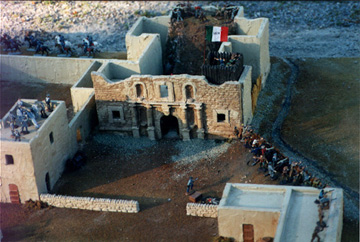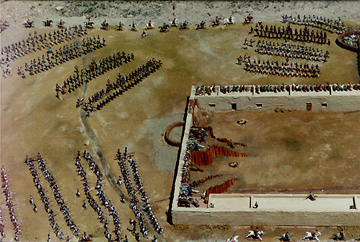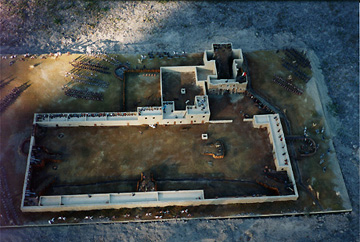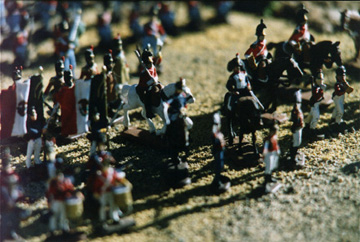
The Alamo:
A Scale Model and a Model for Teaching Research Skills
By Dan Arnsan
©1996-1997, Dan Arnsan. All Rights Reserved.
Nearly every native-born U.S. college student knows something about the Alamo. One doesn't need to be a history major to be familiar with the battle cry, "Remember the Alamo!" Who isn't aware that Davy Crockett died at the Alamo? With this basic assumption in mind, I use the Alamo in teaching research skills to college students.
I'm a librarian at Palomar College, a two-year college located in San Marcos, California, approximately 30 miles north of San Diego. I enjoy history and use historical events to introduce students to research techniques and the concept of critical thinking in preparing research papers. Because history can be deadly boring, I look for stimulating, controversial subjects and attempt to introduce the more human aspects of famous historical figures. I have dressed up like Teddy Roosevelt, passed around a bullet from the Civil War, shared my scale model of the Titanic and displayed rubble from Manzanar, The California internment camp that held over 10,000 Japanese Americans during World War II.
The Alamo remains one of my favorite examples because it has all the elements of a major research challenge combined with all the ingredients of a great story. The Alamo has controversy, suspense, adventure, bigger-than-life heroes (and heroines), and a plethora of unsolved mysteries as well. No wonder it has been such a popular setting for films and TV.
To stimulate critical thinking, I discuss the role of films and folklore in establishing the concept of the Alamo we share. Students are fascinated to learn that the Alamo chapel front, an American icon, in the beginning didn't look the way it does today or as it has been portrayed in most films. We discuss Disney's Alamo as presented in the 1955 series, "Davy Crockett, King of the Wild Frontier," and, of course, John Wayne's classic 1960 film, "The Alamo."
I attempt to point out some of the obvious historical mistakes and inconsistencies and discuss the difference between creative license and just bad research. Davy's fictional sidekicks, Georgie Russell, Thimblerig and the mute Indian were just Disney's attempt to flesh out the story Disney style. With so many interesting characters in the real Alamo, it is too bad Disney felt compelled to invent fictional characters. As I look back at this classic TV series, I'm particularly sorry that Disney left the Mexican side of the story so one-dimensional.

John Wayne's film was flawed with a number of details most of the movie-going public could care less about, but they were easy to fix details that could have been eliminated with careful research. Someone did research on Mexican uniforms for Mr. Wayne but not necessarily on uniforms worn at the Alamo. There is an outrageous range of colors and uniform styles in the film. John Wayne mortgaged his home to help finance this epic, which he produced, directed and even starred as Davy Crockett. In spite of Mr. Wayne's attempts to make it the "best" Alamo film, he portrayed the famous chapel front inaccurately by adding two additional second level windows.
Perhaps I'm being too critical. The Disney TV series and the John Wayne film stand on their own for other reasons. Disney's Crockett at the Alamo, when I saw it at the age of nine, inspired my lifelong interest in the subject. My boyhood friend, Bobby Potter, will always carry a scar on the bridge of his nose where I clobbered him with my official Davy Crockett Old Betsy musket as he attempted, with the rest of the "Mexican Army" to scale the walls of my grandmother's porch. John Wayne's film was nominated for seven academy awards including best picture and still sends shivers down my spine when I think about Santa Anna's army lining up for the final assault.
I have used the media's portrayal of the Alamo in my research classes and library orientations because it is something nearly anyone can relate to if only in a fleeting way. I next discuss the importance of primary resources to discover not only what really might have taken place but to convey the underlying human emotions. I have read Travis' classic appeal for help from Goliad as an example.
I move on to discuss the concept of "hero." I ask the Question, "Were Travis, Bowie, Crockett and the other defenders heroes or were they interlopers and opportunists prepared to open Texas up to slavery?" We also discuss the unsung heroes, the soldados, who fought and died bravely for Mexico and about their leader, Santa Anna, history's great "come-back-man." We have had some stimulating discussions, especially among the Mexican-American students about the role of the Alamo in U.S. history. I attempt to remain objective and let the discussion go where it will. I plant the seeds and let them grow as the most disinterested student finds something to relate to in the Alamo and its major and minor players, not forgetting Susannah Dickinson, Angelina and the other women of the Alamo.

In addition to instructor led discussions, I have constructed a 1/72 scale model of the Alamo to help students relate to and visualize the battle as it unfolded. Built on a 4'x8' piece of plywood, I consider the model a work-in-progress. Yes, it looks finished, but I am constantly changing it as I learn more from my research and as experts learn more from archaeological digs.
Since I discovered "The Second Flying Company of Alamo de Parras," several weeks ago I have been gently guided by editor, Randell Tarin, and Alamo Battlefield Association President, Kevin Young, to correct a few of my own research errors in the model. Before submitting the photographs of the model, I repainted the jackets of over 200 miniature "soldados" from white to regulation blue. I had repeated the same mistake made in several films and by several book illustrators by portraying the figures in their fatigues (camp/working uniforms). Kevin Young also introduced me to Stephen Hardin's excellent book, Texian Iliad. The Hardin book reveals evidence of beehive ovens in the Alamo's cattle pen. Using clay snagged from my ceramist wife, I've added the ovens to the model. Hardin also notes a stockade like structure at the southwest corner of the chapel. I also incorporated this change to the model. The major portion of the model/diorama was constructed last year using drawings, maps and descriptions from sources included in my bibliography.
I am certain there will be those who take exception to the 1824 constitution flag flying over the chapel of the model. This is a John Wayne hangover I'm having trouble shaking. Anyway, the jury is still out on Alamo flags.
The model, constructed at my summer home in Montana, is too cumbersome to transport to California. Last academic year, in order to share my creation, I disassembled the chapel, detached a couple of hundred soldado figures and about twenty Texians and reconstructed a "selectively compressed" diorama. I reminded my students that I was taking historical license like Disney and Wayne. This year I will again reconstruct the miniature diorama but I've also taken slides of the entire model similar to the photos displayed here.

I will be happy to provide details to anyone interested in the construction of the model/diorama. I will attempt to answer questions and listen to suggestions through the Alamo Forum.
Anyone wishing to make their own scale model might consider contacting The Toy Soldier Company to obtain miniature figures in a variety of scales. The Toy Soldier Co, is owned by James Delson, 100 Riverside Dr., New York, NY 10024- Phone: (201) 433-2370.
Just briefly, I'll cover the basics of the construction of my scale model Alamo. The chapel and compound are constructed from balsa wood, foam core and resin "stone walls" I obtained from a model railroad store. By the way, 1/72 scale is very close to model railroad "HO" scale. All buildings and walls were then covered with vinyl spackling and painted with flat acrylic paint. The chapel front, as the heart of the Alamo, was a special challenge. I began with the resin stone wall material, carefully cut out the door and windows and added balsa wood details in layers. The columns were made from furniture dowels. I used vinyl spackling to fill, construct details and selectively cover the stone wall so that some stone texture shows through. The plywood diorama base was painted with brown acrylic paint and, while still wet, covered with sand and ground landscaping foam (again from model railroad sources). I didn't have a router so I chiseled out the irrigation ditches and filled the ditch adjacent to the north wall with clear resin to make it appear like flowing water.
My Alamo model/diorama is not perfect. As I explain to my students, there are many things we will never know about the Alamo and other historical events, but careful research is revealing more information all the time. I don't expect every student to share my love of history and my special fascination with this portion of Texas history, but I do know that they will..."Remember the Alamo!" – August 1997
Photos by the Author.
Alamo Model Construction Bibliography